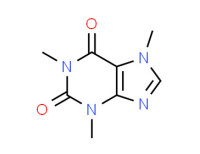
Item name:
Caffeine
Description:
Caffeine anhydrous is dehydrated form of caffeine found in the seeds, nuts, or leaves of a number of plants,its chemical formula is C8H10N4O2. The chemical classification of caffeine is Xanthines. Caffeine is a methylxanthine alkaloid found in the seeds, nuts, or leaves of a number of plants native to South America and East Asia that is structurally related to adenosine and acts primarily as an adenosine receptor antagonist with psychotropic and anti-inflammatory activities. Upon ingestion, caffeine binds to adenosine receptors in the central nervous system (CNS), which inhibits adenosine binding. This inhibits the adenosine-mediated downregulation of CNS activity; thus, stimulating the activity of the medullary, vagal, vasomotor, and respiratory centers in the brain. This agent also promotes neurotransmitter release that further stimulates the CNS. The anti-inflammatory effects of caffeine are due the nonselective competitive inhibition of phosphodiesterases (PDEs). Inhibition of PDEs raises the intracellular concentration of cyclic AMP (cAMP), activates protein kinase A, and inhibits leukotriene synthesis, which leads to reduced inflammation and innate immunity.
Group:
Additives
CAS Number:
58-08-2
EC Number:
200-362-1
Synonyms:
1H-Purine-2,6-dione, Caffeine, Koffein, Caffeine anhydrous, Caffeine fghfg, Caffeine 98-99% BP/USP grade, CAFFEINE ANHYDROUS POWDER PHARMA, CAFFEINE ANHYDROUS PHARMA, CAFFEINE ANHYDROUS FOOD, CAFFEINE ANHYDROUS COSMETIC FOOD PHARMA
Applications:
Consumer use, Personal Care, Food, Feed, Pesticide
Ipuac Name:
1,3,7-trimethylpurine-2,6-dione
Molecular Formula:
C8H10N4O2
Molecular Weight:
194.194 g/mol
Boiling Point:
178°C
Flash Point:
178°C
Melting Point:
234-236.5 °C(lit.)
Density:
1.23 g/cm3
Hazard Class:
6.1
HS Code:
2939300010
RID/ADR:
UN 1544 6.1/PG 3
Risk Statements:
R22; R25
Hazard Declaration:
H302
Caution Statement:
P264, P270, P301+P312, P330, and P501
Signal World:
Warning
Supplier(s): 45

Univar Solutions GmbH
Germany
Caffeine
Shipment available

UAB SynHet
Lithuania
Caffeine
Shipment available

TER Chemicals Distribution Group
Germany
Caffeine
Shipment available
Caffeine
Shipment available
Caffeine
Shipment available

Shin-Etsu
United States of America
Caffeine
Shipment available
Caffeine
Shipment available

STOCKMEIER HOLDING GMBH
Germany
Caffeine
Shipment available

STANLAB
Poland
Caffeine
Shipment available

Rebain International NL
Netherlands, Kingdom of the
Caffeine
Shipment available

Radchem Products, Inc.
United States of America
Caffeine
Shipment available

RT VANDERBILT HOLDING CO INC
United States of America
Caffeine
Shipment available

QUIMIDROGA S.A.
Spain
Caffeine
Shipment available
Caffeine
Shipment available

OQEMA
Germany
Caffeine
Shipment available
Caffeine
Shipment available

Nanjing Lanya Chemical
China
Caffeine
Shipment available

Molekula
Germany
Caffeine
Shipment available
Caffeine
Shipment available

Matrix Fine Chemicals GmbH
Switzerland
Caffeine
Shipment available

MT Chemtech
Japan
Caffeine
Shipment available
Caffeine
Shipment available

Julius Hoesch GmbH & Co. KG
Germany
Caffeine
Shipment available

Jebsen & Jessen Life Science
Germany
Caffeine
Shipment available

Intrachem Limited
Ireland
Caffeine
Shipment available

Inter-Harz GmbH
Germany
Caffeine
Shipment available

IMCD Deutschland GmbH
Germany
Caffeine
Shipment available
Caffeine
Shipment available

HSH Chemie d.o.o.
Slovenia
Caffeine
Shipment available

HARKE Chemicals GmbH
Germany
Caffeine
Shipment available

Greenchem
United States of America
Caffeine
58-08-2
DDP
USA, Canada, Mexico
Shipment available

Evonik Industries AG
Germany
Caffeine
Shipment available

Donauchem GmbH
Austria
Caffeine
Shipment available
Caffeine
Shipment available

Chemicals United B.V.
Netherlands, Kingdom of the
Caffeine
Shipment available
Caffeine
Shipment available

Brenntag Polska
Poland
Caffeine
Shipment available

Brenntag GmbH
Germany
Caffeine
Shipment available

Bazayan & Co
India
Caffeine
Shipment available

BILTREC
Spain
Caffeine
Shipment available

BCD Chemie GmbH
Germany
Caffeine
Shipment available

Azelis Deutschland GmbH
Germany
Caffeine
Shipment available

Apollo Scientific LTD
United Kingdom
Caffeine
Shipment available

ALTEQO
Netherlands, Kingdom of the
Caffeine
Shipment available

ALL Chemistry Inc.
United States of America
Caffeine
Shipment available
